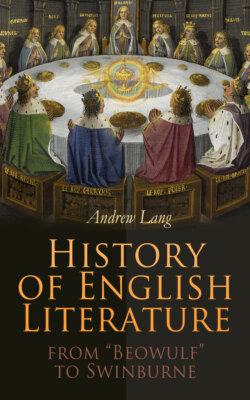Читать книгу History of English Literature from "Beowulf" to Swinburne - Andrew Lang, Robert Kirk - Страница 59
На сайте Литреса книга снята с продажи.
Other Early Poems.
Оглавление"The Compleynte unto Pite" (Pity) is the earliest of Chaucer's poems in "Rhyme Royal" (so called, some think, because James I of Scotland used it much later in "The King's Quhair," a far-fetched guess). The poet seeks Pity, and finds her dead; he adds the petition which he meant to have presented to her, that of a despairing lover. The ideas are hackneyed, and the piece is a mere exercise. The metre, later much used by Chaucer in narrative runs thus:—
This is to seyne, I wol be youres ever;
Though ye me slee by Crueltee, your fo,
Algate my spirit shal never dissever
Fro your servyse, for any peyne or we.
Sith ye be deed,—alias! that hit is so!—
Thus for your deth I may wel wepe and pleyne
With herte sore and fill of besy peyne.
The "A.B.C." is a hymn of prayer to Our Lady, each stanza beginning with each successive letter of the alphabet. It is an exercise in translation from a French original; the stanzas are shorter than in the French.
"The Compleynte of Mars" tells of the wooing of a mediaeval Mars and Venus, interrupted by Apollo "with torche in honde"; the original source of the story is the song of the Phæacian minstrel in the "Odyssey," but that is humorous, while Chaucer is sympathetic; Mars asks poets not to make game of his passion,
take hit noght a-game.
The Phæacian singer did "take it a-game".
"A Compleynte to his Lady" is of the conventional kind, and an exercise in metres.
"Anelida and Arcite" is also scholar's work, but the scholar has now learned Italian, during his Italian mission of 1372; has read and in places translates the "Teseide" of Boccaccio, which he often utilized. He had also Statius, a late Latin poet, and other models, or he dealt in his own inventions. As in the "Knight's Tale," Theseus returns from conquered Scythia, with his bride, Hippolyta, Queen of the Amazons, and her sister, Emily, the heroine of the "Knight's Tale". The unpopular tyrant, Creon, is ruling in Thebes, where Anelida loves Arcite, who is a true lover, in the "Knight's Tale," but here "double in love," a follower of Lamech, in Genesis, the first man who loved two ladies at once. His second love holds him tightly "up by the bridle," so Anelida despairs, expressing her woe in a kind of ode, strophe and anti-strophe, in stanzas of eight, and next of nine lines, with complicated rhymes, finally with rhymes in the middle as well as at the end of each line. The poem, more interesting than the previous experiments, and not without passion, is unfinished: ends abruptly.
"The Parlement of Fowls" appears to be a kind of Laureate's Ode on the marriage (January, 1382) of Richard II with Anne of Bohemia, who previously had two other wooers, a Prince of Bavaria, and the Margrave of Meissen. When the Birds hold their Parliament, the Formel Eagle represents Anne, Richard is the Royal Tercel Eagle, the two other tercels are the German wooers. Chaucer was always a most literary poet, and was still an adaptive poet. As he must begin with a dream, he versifies the contents of Cicero's "Dream of Scipio": he takes a little from Dante, a little from Claudian, the whole Pageant of Birds he borrows from Alain Delille's "Plaint of Nature," greatly improving on it, while, in the debate of the birds on St. Valentine's Day, as to which tercel shall win the formel tercel, he gives way to his own sense of humour. The verses are vers de société, designed not for our taste, but for that of the society of his time. Chaucer himself perceived the tediousness of the love-pleading of the tercels: like the Host in the "Canterbury Tales," when bored by Sir Thopas and the Monk's tragedies, the jury of birds cry to be released,
The noise of foules for to ben delivered
So loude rong, "have doon and let us wende!"
In giving their verdicts the Goose is remote from sentiment, saying to the unsuccessful wooer,
But she wol love him, lat him love another!
The turtle-dove blushes, and gives her word for immortal hopeless love. The poem, in the seven line stanza, ends with a rondel, confessedly translated from the French, and the poet wakens from his dream and returns to his dear books, on the look-out for new material. He has shown his mastery of style, and his knowledge, but he has not yet "come to his kingdom".
